Why a Structured Environment for Healing is Crucial
As someone who’s spent over two decades working with individuals diagnosed with complex mental health conditions, I’ve seen firsthand the transformative power of structured environments in bipolar disorder inpatient treatment. These settings offer a comforting rhythm and consistency, where patients can stabilize and thrive. They provide a regimented daily schedule encompassing therapy sessions, medication management, and recreational activities, reducing the chaos that often accompanies bipolar episodes. By embedding these elements into everyday routines, patients can better manage their symptoms and regain both control and confidence.
Structured environments aren’t just about rigid schedules; they’re dynamic spaces designed to offer holistic support. For instance, at Alta Loma, we’ve witnessed considerable improvements in patients who have ongoing access to recreational therapies like art and music, which encourage self-expression and emotional processing. Moreover, structured environments facilitate peer interactions, creating a sense of community and mutual support among patients. This atmosphere enables individuals to share experiences and coping strategies, enhancing their overall sense of belonging and resilience.
The Multifaceted Treatment Approach
In bipolar disorder inpatient treatment, a multifaceted approach isn’t just beneficial; it’s essential. Our team at Alta Loma integrates various therapeutic modalities, ensuring each patient’s unique needs are met. These can range from cognitive-behavioral therapy (CBT) to tailored nutritional guidance. Nutritional planning plays a pivotal role in stabilizing mood swings, as we’ve found that a balanced diet can significantly influence mental wellness. Our dieticians work closely with patients, crafting personalized meal plans to combat the dietary deficiencies often linked to mood fluctuations.
Another cornerstone of our approach is medication management. Collaborating with psychiatrists, we focus on finding the right medication balance, recognizing that what works for one patient may not be effective for another. Through close monitoring and regular evaluations, we adapt treatment plans to respond to any changes in symptoms or side effects, ensuring optimal results. By combining psychotherapy, medication, and lifestyle interventions, our treatment plans evolve alongside our patients’ recovery journeys.
- Cognitive-Behavioral Therapy (CBT)
- Nutrition Planning
- Recreational Therapy
- Medication Management
- Community Integration
Bipolar Inpatient Treatment vs. Outpatient Care
A key question in mental health care is deciding when bipolar disorder inpatient treatment is necessary compared to outpatient care. From my experience, inpatient treatment is most beneficial for patients experiencing severe manic or depressive episodes that disrupt daily functioning. The 24/7 care available in inpatient settings allows for immediate intervention, which is crucial when addressing acute symptoms that could lead to safety concerns.
Outpatient care, on the other hand, is ideal for individuals with stable symptoms looking to maintain their progress post-inpatient treatment. It offers flexible support through periodic therapy sessions while patients continue their daily activities. One of the primary benefits of bipolar disorder inpatient treatment is the comprehensive approach to symptom management coupled with immediate access to healthcare professionals. This is particularly useful for those who need intensive support that outpatient settings might not provide.
What Qualifies as a Bipolar Disorder Inpatient Treatment Emergency?
An emergency situation requiring bipolar disorder inpatient treatment often involves severe mania or depression that poses a safety risk to the individual or others. This includes episodes of psychosis, suicidal thoughts, or engaging in high-risk behaviors. Immediate intervention in such scenarios helps manage symptoms quickly, preventing escalation.
At Alta Loma, we’ve embraced a proactive first response system. Our skilled crisis intervention teams are prepared to manage acute episodes and stabilize patients swiftly. This approach minimizes long-term impacts and lays the groundwork for effective ongoing care. Such emergencies underscore the importance of having a robust support system and a readily accessible treatment facility.
- Recognize the signs: Severe mood swings, hallucinations, and self-harm tendencies.
- Contact a healthcare provider immediately for guidance.
- Ensure that the individual is in a safe environment until help arrives.
- Utilize emergency services if the situation escalates beyond manageable levels.
Integrating Family Support in Treatment
Family involvement in bipolar disorder inpatient treatment is vital for sustained recovery. At Alta Loma, we encourage family members to participate in therapy sessions, providing them with insights into the patient’s condition and coping mechanisms. Families learn effective communication strategies and emotional support techniques, which are crucial when the patient transitions back home.
Family therapy sessions create a platform for open dialogue, addressing any misconceptions and fostering understanding. This collaborative approach ensures that patients have a supportive home environment, significantly reducing relapse rates. Families often express how these sessions transform their perceptions and relationships, making recovery a shared journey rather than an isolated struggle.
Family members are also educated about the nature of bipolar disorder, exploring how it impacts behaviors and interactions. By gaining a deeper understanding, they become more empathetic and equipped to provide the necessary support. This holistic approach not only aids the patient’s recovery but also strengthens familial bonds, promoting a healthier dynamic overall.







